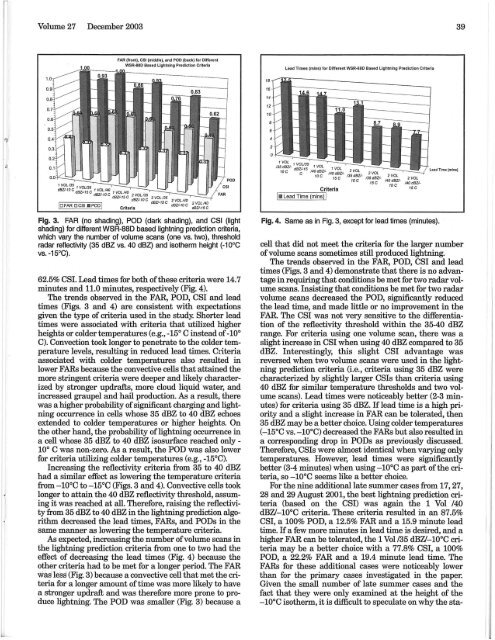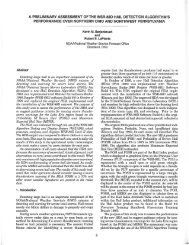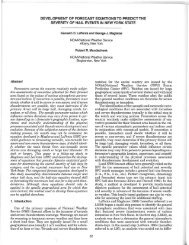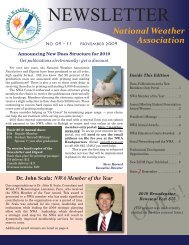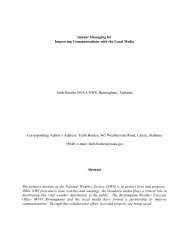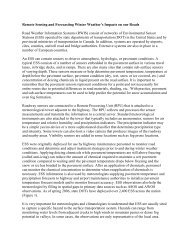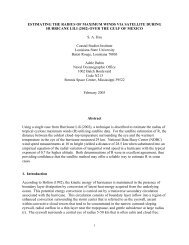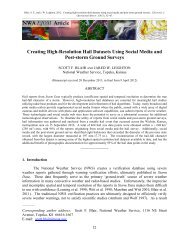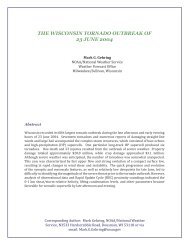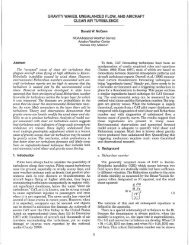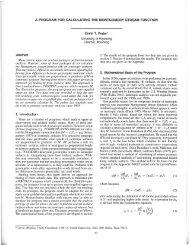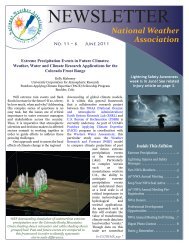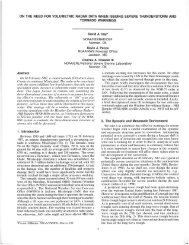Using WSR-88D reflectivity data for the prediction of cloud-to-ground ...
Using WSR-88D reflectivity data for the prediction of cloud-to-ground ...
Using WSR-88D reflectivity data for the prediction of cloud-to-ground ...
Create successful ePaper yourself
Turn your PDF publications into a flip-book with our unique Google optimized e-Paper software.
Volume 27 December 2003<br />
39<br />
Le ad Times (mlns) <strong>for</strong> Different <strong>WSR</strong>-<strong>88D</strong> Based Lightning Prediction Criteri a<br />
18<br />
16<br />
14<br />
12<br />
10<br />
1 VOL IJS 1 VOWS<br />
dBlI·l0e d8Z1-15 C 1 VOL/40 1 VOL 140<br />
dBZI-fo e dBZI.15C 2VOL 13S 2VOL /35<br />
r==-=c:::-=~ d8l/-<strong>to</strong> C dBZf.1 5 C ~:~_;~4g 2 VOL/40<br />
IOFAR OCSI . POD I Criteria dBl/-15C<br />
POD<br />
1 VOL 1 VOU3S ' I<br />
/35 dBZI- dBZI-15 1 VOL 1 VOL<br />
10 C C /40 dBZI- /4 0 dBl/-<br />
10e 15C<br />
r--.,-----:-=----,-.,...-C.:::.:, r.iteria<br />
I_ Lead Time (mins) 1<br />
Load Tlmo (mlns)<br />
Fig. 3. FAR (no shading), POD (dark shading), and CSI (light<br />
shading) <strong>for</strong> different <strong>WSR</strong>-<strong>88D</strong> based lightning <strong>prediction</strong> criteria,<br />
which vary <strong>the</strong> number <strong>of</strong> volume scans (one vs. two), threshold<br />
radar <strong>reflectivity</strong> (35 dBZ vs. 40 dBZ) and iso<strong>the</strong>rm height (-10°C<br />
vs. -15°C).<br />
62.5% CSI. Lead times <strong>for</strong> both <strong>of</strong> <strong>the</strong>se criteria were 14.7<br />
minutes and 11.0 minutes, respectively (Fig. 4).<br />
The trends observed in <strong>the</strong> FAR, POD, CSI and lead<br />
times (Figs. 3 and 4) are consistent with expectations<br />
given <strong>the</strong> type <strong>of</strong> criteria used in <strong>the</strong> study. Shorter lead<br />
times were associated with criteria that utilized higher<br />
heights or colder temperatures (e.g., -15° C instead <strong>of</strong> _10°<br />
C). Convection <strong>to</strong>ok longer <strong>to</strong> penetrate <strong>to</strong> <strong>the</strong> colder temperature<br />
levels, resulting in reduced lead times. C!iteria<br />
associated with colder temperatures also resulted in<br />
lower FARs because <strong>the</strong> convective cells that attained <strong>the</strong><br />
more stringent criteria were deeper and likely characterized<br />
by stronger updrafts, more <strong>cloud</strong> liquid water, and<br />
increased graupel and hail production. As a result, <strong>the</strong>re<br />
was a higher probability <strong>of</strong> significant charging and lightning<br />
occurrence in cells whose 35 dBZ <strong>to</strong> 40 dBZ echoes<br />
extended <strong>to</strong> colder temperatures or higher heights. On<br />
<strong>the</strong> o<strong>the</strong>r hand, <strong>the</strong> probability <strong>of</strong> lightning occurrence in<br />
a cell whose 35 dBZ <strong>to</strong> 40 dBZ isosurface reached only -<br />
10° C was non-zero. As a result, <strong>the</strong> POD was also lower<br />
<strong>for</strong> criteria utilizing colder temperatures (e.g., -15°C).<br />
Increasing <strong>the</strong> <strong>reflectivity</strong> criteria from 35 <strong>to</strong> 40 dBZ<br />
had a similar effect as lowering <strong>the</strong> temperature criteria<br />
from -lOoC <strong>to</strong> -15°C (Figs. 3 and 4). Convective cells <strong>to</strong>ok<br />
longer <strong>to</strong> attain <strong>the</strong> 40 dBZ <strong>reflectivity</strong> threshold, assuming<br />
it was reached at all. There<strong>for</strong>e, raising <strong>the</strong> <strong>reflectivity</strong><br />
from 35 dBZ <strong>to</strong> 40 dBZ in <strong>the</strong> lightning <strong>prediction</strong> algorithm<br />
decreased <strong>the</strong> lead times, FARs, and PODs in <strong>the</strong><br />
same manner as lowering <strong>the</strong> temperature criteria.<br />
As expected, increasing <strong>the</strong> number <strong>of</strong> volume scans in<br />
<strong>the</strong> lightning <strong>prediction</strong> criteria from one <strong>to</strong> two had <strong>the</strong><br />
effect <strong>of</strong> decreasing <strong>the</strong> lead times (Fig. 4) because <strong>the</strong><br />
o<strong>the</strong>r criteria had <strong>to</strong> be met <strong>for</strong> a longer period. The FAR<br />
was less (Fig. 3) because a convective cell that met <strong>the</strong> criteria<br />
<strong>for</strong> a longer amount <strong>of</strong> time was more likely <strong>to</strong> have<br />
a stronger updraft and was <strong>the</strong>re<strong>for</strong>e more prone <strong>to</strong> produce<br />
lightning. The POD was smaller (Fig. 3) because a<br />
Fig.4. Same as in Fig. 3, except <strong>for</strong> lead times (minutes).<br />
cell that did not meet <strong>the</strong> criteria <strong>for</strong> <strong>the</strong> larger number<br />
<strong>of</strong> volume scans sometimes still produced lightning.<br />
The trends observed in <strong>the</strong> FAR, POD, CSI and lead<br />
times (Figs. 3 and 4) demonstrate that <strong>the</strong>re is no advantage<br />
in requiring that conditions be met <strong>for</strong> two radar volume<br />
scans. Insisting that conditions be met <strong>for</strong> two radar<br />
volume scans decreased <strong>the</strong> POD, significantly reduced<br />
<strong>the</strong> lead time, and made little or no improvement in <strong>the</strong><br />
FAR. The CSI was not very sensitive <strong>to</strong> <strong>the</strong> differentiation<br />
<strong>of</strong> <strong>the</strong> <strong>reflectivity</strong> threshold within <strong>the</strong> 35-40 dBZ<br />
range. For criteria using one volume scan, <strong>the</strong>re was a<br />
slight increase in CSI when using 40 dBZ compared <strong>to</strong> 35<br />
dBZ. Interestingly, this slight CSI advantage was<br />
reversed when two volume scans were used in <strong>the</strong> lightning<br />
<strong>prediction</strong> criteria (i.e., criteria using 35 dBZ were<br />
characterized by slightly larger CSIs than criteria using<br />
40 dBZ <strong>for</strong> similar temperature thresholds and two volume<br />
scans). Lead times were noticeably better (2-3 minutes)<br />
<strong>for</strong> criteria using 35 dBZ. If lead time is a high priority<br />
and a slight increase in FAR can be <strong>to</strong>lerated, <strong>the</strong>n<br />
35 dBZ may be a better choice. <strong>Using</strong> colder temperatures<br />
(-15°C vs. _lOOC) decreased <strong>the</strong> FARs but also resulted in<br />
a corresponding drop in PODs as previously discussed.<br />
There<strong>for</strong>e, CSIs were almost identical when varying only<br />
temperatures. However, lead times were significantly<br />
better (3-4 minutes) when using -lOoC as part <strong>of</strong> <strong>the</strong> criteria,<br />
so -lOoC seems like a better choice.<br />
For <strong>the</strong> nine additional late summer cases from 17, 27,<br />
28 and 29 August 2001, <strong>the</strong> best lightning <strong>prediction</strong> criteria<br />
(based on <strong>the</strong> CSI) was again <strong>the</strong> 1 Vol /40<br />
dBZI-lOoC criteria. These criteria resulted in an 87.5%<br />
CSI, a 100% POD, a 12.5% FAR and a 15.9 minute lead<br />
time. If a few more minutes in lead time is desired, and a<br />
higher FAR can be <strong>to</strong>lerated, <strong>the</strong> 1 Vol /35 dBZI-lOoC criteria<br />
may be a better choice with a 77.8% CSI, a 100%<br />
POD, a 22.2% FAR and a 19.4 minute lead time. The<br />
FARs <strong>for</strong> <strong>the</strong>se additional cases were noticeably lower<br />
than <strong>for</strong> <strong>the</strong> primary cases investigated in <strong>the</strong> paper.<br />
Given <strong>the</strong> small number <strong>of</strong> late summer cases and <strong>the</strong><br />
fact that <strong>the</strong>y were only examined at <strong>the</strong> height <strong>of</strong> <strong>the</strong><br />
-lOoC iso<strong>the</strong>rm, it is difficult <strong>to</strong> speculate on why <strong>the</strong> sta-


